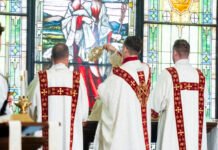The Worshipful David Hodge QC, Deputy Chancellor for the Diocese of Ely has rendered a very clear and carefully nuanced judgement in regard to the Tobias Rustat Memorial controversy at Jesus College in Cambridge. Hodge ruled agains the effort brought by the new Master of Jesus College, Sonita Alleyne to have the memorial removed. Alleyne’s attempt was supported by the current Archbishop of Canterbury.
The case was heard by the Deputy Chancellor from 2-4 February in the Chapel of Jesus College.
Mr Mark Hill QC represented Jesus College and Mr Justin Gas and Professor Lawrence Goldman represented those in opposition.Deputy Chancellor Hodge disagreed with the assertions made about the memorial and his ruling in part said:
“I am not satisfied that the removal of the memorial is necessary to enable the Chapel to play its proper role in providing a credible Christian ministry and witness to the College community, or for it to act as a focus for secular activities and events in the wider life of the College. I am not satisfied that the relocation of the memorial to an exhibition space where it can be contextualised is the only, or, indeed, the most appropriate, means of addressing the difficulties which the presence of the Rustat memorial in the College Chapel is said to present. (Paragraph 6)
A False Narrative Introduced
“No-one disputes that slavery and the slave trade are now universally recognised to be evil, utterly abhorrent, and repugnant to all right-thinking people, wherever they live and whatever their ethnic origin and ancestry. They are entirely contrary to the doctrines, teaching and practices of the modern Church. However, on the evidence, I am satisfied that the parties opponent have demonstrated that the widespread opposition to the continued presence of the Rustat memorial within the College Chapel is indeed the product of the false narrative that Rustat had amassed much of his wealth from the slave trade, and that it was moneys from this source that he used to benefit the College. The true position, as set out in the historians’ expert reports and their joint statement, is that Rustat’s investments in the Company of Royal Adventurers Trading into Africa (the Royal Adventurers) brought him no financial returns at all; that Rustat only realised his investments in the Royal African Company in May 1691, some 20 years after he had made his gifts to the College, and some five years after the completion of the Rustat memorial and its inscription; and that any moneys Rustat did realise as a result of his involvement in the slave trade comprised only a small part of his great wealth, and they made no contribution to his gifts to the College. I recognise that for some people it is Rustat’s willingness to invest in slave trading companies at all, and to participate in their direction, rather than the amount of money that he made from that odious trade, that makes the Rustat memorial such a problem. I recognise also that it does not excuse Rustat’s involvement in the slave trade, although it may help to explain it, that, in the words of L. P. Hartley (in his 1953 novel, The Go-Between), “The past is a foreign country: they do things differently there.” I also acknowledge that there is no evidence that Rustat ever repented for his involvement in the slave trade, unlike, for example, the reformed slave ship captain, the Reverend John Newton, whose hymn ‘How Sweet the name of Jesus Sounds’ was sung at the beginning of the service of Choral Evensong which I attended at the College Chapel and whose history I had to consider in the context of the creation of an educational area dedicated to his life and work in my judgment in Re St Peter & St Paul, Olney [2021] ECC Oxf 2. However, I would hope that, when Rustat’s life and career is fully, and properly, understood, and viewed as a whole, his memorial will cease to be seen as a monument to a slave trader.” (Paragraph 8)
Noting that church buildings must be safe spaces where no harm should come to visitors, the judge held such “does not mean that it should be a place where one should always feel comfortable, or unchallenged by difficult, or painful, images, ideas or emotions, otherwise one would have to do away with the painful image of Christ on the cross, or images of the martyrdom of saints.” (Paragraph 9)
Church Buildings Are Where God is Worshipped…Not the People on the Walls
Deputy Chancellor Hodge then got to the heart of the question: A church building is a place where God (not the people remembered on its walls) is worshipped and venerated, and where we recall and confess our sins, and pray for forgiveness. Whenever a Christian enters a church to pray, they will invariably utter the words our Lord taught us, which include asking forgiveness for our trespasses (or sins), “as we forgive them that trespass against us”. Such forgiveness encompasses the whole of humankind, past and present, for we are all sinners; and it extends even to slave traders.” (Paragraph 9)
There is some question as to whether the ruling will be appealed. If so, it will be appealed to the Court of the Arches, the Provincial Court of Appeals for the Province of Canterbury.



